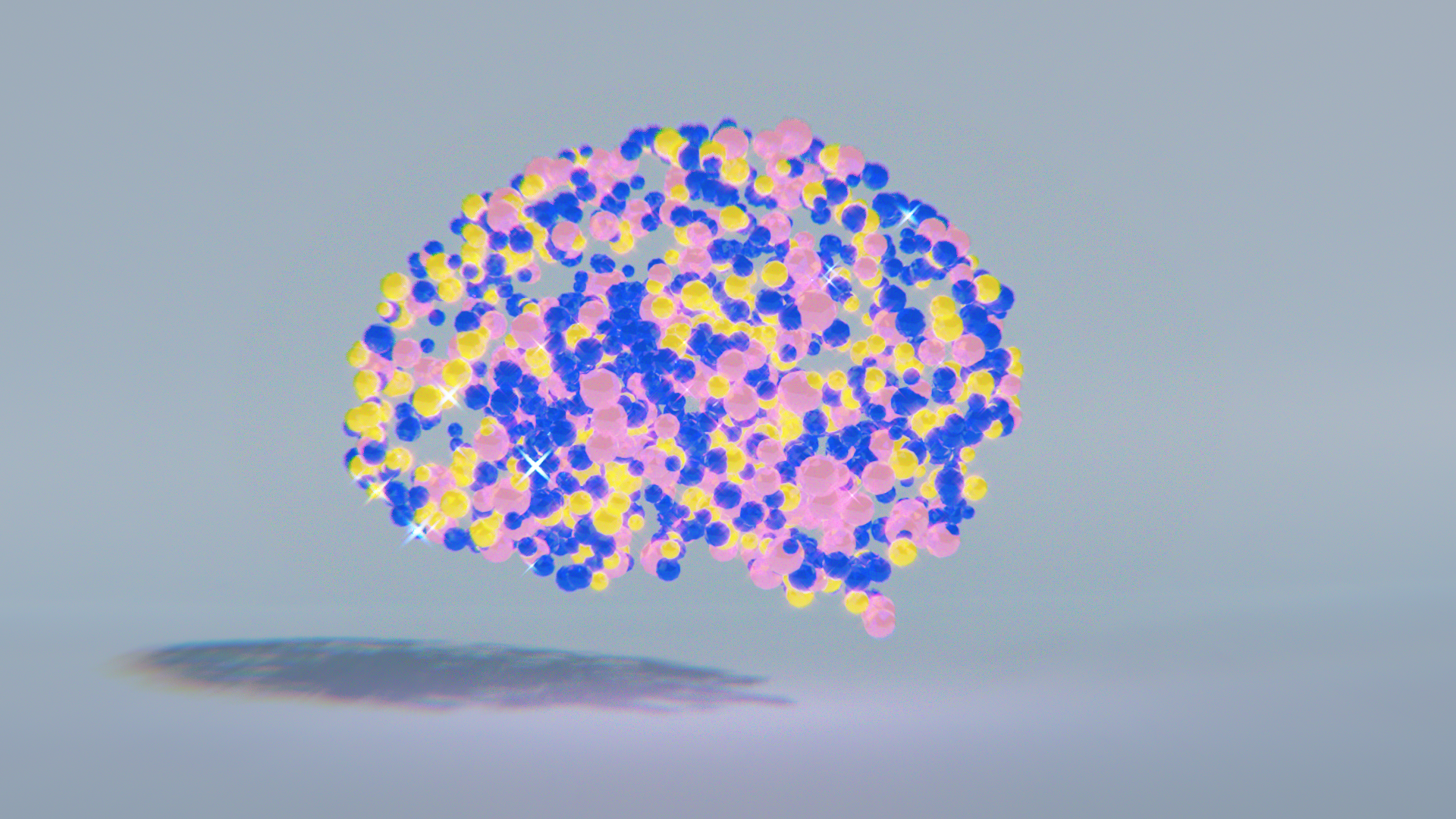The urban brain
Mental health in the city

For some people, the city is a place where you can be yourself and thrive, but for others, living in the city can be a struggle. Researchers at the UvA Centre for Urban Mental Health explore how city dwellers can maintain or achieve mental health.
'Look, that car just cut off that cyclist without any warning. And now there’s a tram tearing around the corner.' Professor Claudi Bockting peers out of her office window above the Munt and observes the crossing from the point of view of her own expertise. 'Anyone walking or cycling here has to be alert and has to process a lot of stimuli just to get to the other side of the street unscathed.'
'But at the same time there are a lot of positives,' responds professor Reinout Wiers. Wiers, together with Bockting, is one of the co-directors of the UvA Centre for Urban Mental Health. 'There are trees, the water is gently rippling in the canal, the historical facades are visually interesting. It all looks quite different from a random shopping centre in Hoogezand-Sappemeer. And most important: it’s very lively here and you’re surrounded by people.'
'The city is both
an appealing and
a challenging environment for
the soul.'

Just a brief glimpse from our window's vantage point reveals the city as both an appealing and a challenging environment for the soul. Many people thrive living in the city. But Wiers, Bockting and their colleagues have discovered that city dwellers more frequently experience mental disorders compared to people living in rural areas, especially in highly urbanised countries.
What’s behind this? What are some potential interventions that would promote mental health in an urban environment? What is needed to stop frequently occurring disorders such as depression, anxiety, and addiction from unnecessarily spreading further? A burning question, given that annually, 1 out of 4 people living in the Netherlands say they are suffering from a mental disorder, and urbanisation is increasing across the globe. The Centre for Urban Mental Health’s interdisciplinary team is looking for answers.
Urban
Stimuli

In their research, Wiers and Bockting don’t only focus on the separate factors that lead to anxiety, addiction or depression. Instead, they try to look at how all these factors are interrelated. Wiers: ‘It goes without saying that a predisposition for mental problems, your genes, play a role. But there’s so much more to it: noise nuisance, your financial situation, the social connections in your environment, incidents during early childhood, nutrition, migration, social interaction, the opportunities you’re given for personal development, and so on.’
Not just linear cause and effect relationships

Bockting: 'During my psychology studies I was surprised by the tendency to reduce everything to a linear cause and effect relationship. For example, a deficiency in a specific neurotransmitter could lead to depression, or that attachment issues in childhood could be at the root of all kinds of psychopathology. Of course, those factors play a role, but this approach is much too simplistic. And research into these types of cause and effect relationships has not been productive for patients.'
Roughly half the people suffering from frequently occurring mental disorders such as depression, anxiety or addiction can be helped by the medication or therapies that are available. And these people also run a considerable risk of relapse. 'We simply have to do better,' says Bockting. 'Methods adopted from complexity science now give us an opportunity to take a radically different approach when conducting research on mental disorders. We can map the impact of many more factors. These are factors that also have an underlying relationship with each other, and they evolve over time.'
The city
and the lab

In a Science Park meeting room, neuroscientist Rixt van der Veen uses her laptop to show one of the pieces that make up the complex puzzle of urban mental health. The video shows eight young white rats exploring a special cage. One of them rummages around a little house at the bottom of the cage while another rat enjoys the running-wheel. The most inquisitive rat walks up a ladder to a maze located at the upper level of the cage.
‘You could look at this complex cage with animals of the same species as the rodent equivalent of an urban environment,’ says Van de Veen. To illustrate a contrasting environment, she shows a photograph of a smaller rectangular cage with sawdust and food, and only a couple of rats. The larger ‘urban’ cage offers more of a challenge and more to do. And there’s also a social component: more animals living in close proximity to each other. Just like people in the city.’
This kind of complex urban environment has a significant impact on how the rodents develop. Van der Veen: ‘It’s something you observe immediately: the animals are more active, they’re lighter than their counterparts in regular cages. The rats also seem to be a different breed mentally. They are more alert, but at the same time they have a shorter attention span and they’re less socially active. They remind me of street-smart urban adolescents with their ‘been there, done that’ mentality.’
Stress during
early childhood

Now that it’s clear that the urban cage provides Van der Veen with a meaningful research model, she wants to focus on the relationship between unpleasant experiences and social or antisocial behaviour in an urban environment.
She does this by giving female mice with offspring less sawdust to build their nests for the period of a week. That causes stress for the mother and her pups. It’s a tried and tested animal model to mimic insecure attachment. ‘Afterwards, I’m interested to see how the young mice will behave in a social environment. What is the impact of this stress on their behaviour and position in the group later on?'
‘Of course, the purpose of my research isn’t to study how stress early in life affects rodents,’ explains Van der Veen. ‘We’re trying to gain insights that can be applied to people. We know that unpleasant experiences during childhood can play a significant role in the emergence of mental and behavioural problems. You can use an animal model in a controlled setting to differentiate between the exact mechanisms at work. How does the impact of early childhood stress manifest in the brain? What’s the role of the urban environment in this process? You can also conduct research into medication that could mitigate these effects.’
Apps and urban gardens

Wiers and Bockting believe that if you want an enriched understanding, laboratory research alone isn’t enough. You also need knowledge that comes from outside the walls of academia. For example, they used data provided by healthcare providers and municipalities. Over the past decade, the number of beds in psychiatric clinics has dropped drastically. This particular change could provide some interesting information.
'What are the consequences of this change?', wonders Wiers aloud. 'What’s the impact on patients, healthcare providers and communities? Did patients benefit from a more independent lifestyle? Of were they unsuccessful and end up regularly turning to crisis support services?’ The researchers suspect that what it probably comes down to is that the effects were all over the place. Wiers: 'Obviously the challenge now is to identify the underlying forces responsible for a given outcome.'
For Wiers, Bockting and Van der Veen, the ultimate objective is to understand which low-threshold interventions have a positive impact on mental wellbeing and what approach would work best for common mental health issues in cities. They mention, for example, urban gardens that stimulate physical exercise and contact between people. Another option is combining digital psychological support with personal contact in the neighbourhood. ‘That’s what it’s really about,’ affirms Bockting: ‘helping people who have the misfortune of being vulnerable to mental disorders so there’s some improvement in their condition from day to day.’

Claudi Bockting
Claudi Bockting is hoogleraar Klinische psychologie in de Psychiatrie en co-directeur van het Centre for Urban Mental Health. Ze is gespecialiseerd in veelvoorkomende psychische aandoeningen, zoals depressie en angst en werkt als klinisch psycholoog/psychotherapeut bij het Amsterdam UMC. Ze richt zich in haar onderzoek op beïnvloedbare factoren die een stoornis veroorzaken of in standhouden en de ontwikkeling van innovatieve interventies, waaronder apps, serious games, chatbots and Virtual Reality-behandelingen.

Reinout Wiers
Reinout Wiers is hoogleraar ontwikkelingspsychopathologie aan de Universiteit van Amsterdam en co-directeur van het Centre for Urban Mental Health. Voor zijn werk naar het meten en beïnvloeden van neurocognitieve processen bij verslaving kreeg hij de prestigieuze Vidi- en Vici-subsidies van NWO. Recent verscheen zijn boek Akrasia, over vrije wil, verslaving en verandering, waarin hij inzichten uit de neurowetenschappen, filosofie en psychologie combineert.

Rixt van der Veen
Rixt van der Veen is Principal Investigator bij het Centre for Urban Mental Health en verbonden aan het Swammerdam Institute voor Life Sciences. Ze onderzoekt de effecten van genetische aanleg en stress in het vroege leven op sociaal gedrag. Daarnaast coördineert ze het interdisciplinaire honours vak Urban Mental Health en geeft ze onder meer het vak Science to Business bij biomedische wetenschappen.
